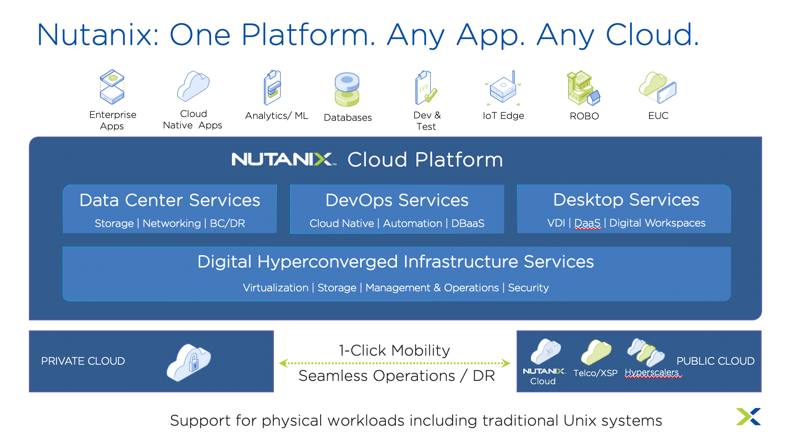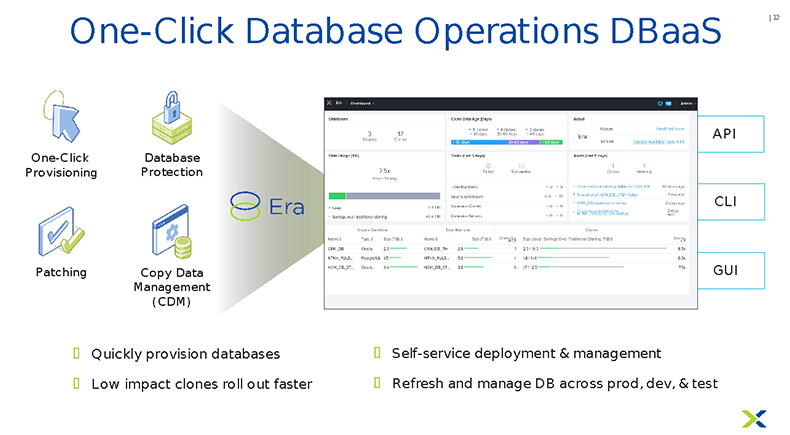What if your organization's databases just worked, with all the complexity and tedium of database administration and maintenance hidden from view? Let's explore what invisible databases might mean in a real world business environment.
Have you ever:
- Needed to quickly restore a multi-terabyte operational database to a point in time and recover the customer’s business from crippling data corruption?
- Received an urgent request from a business user for a copy of a critical Oracle® database while your Oracle database administrator (DBA) was on vacation and there was no more free space on the storage subsystem to host this copy?
- Had to write and maintain complex operational scripts to manage the lifecycle of more than one database type?
- Been asked to support and manage the lifecycle of thousands of test and development database copies with no additional DBAs?
Now imagine that you can:
- Provision any commercial or open-source relational database management system (RDBMS), NoSQL, or in-memory database in minutes without complex scripts.
- Keep database and OS software up to date by automatically applying patches in minutes.
- Rapidly spin up copies of a multi-terabyte database while using almost no additional storage space.
- Provision and manage databases on the public cloud of your choice.
If you answered yes to any of the questions in the first list or considered the possibilities in the second, then you are already thinking about invisible database operations and the Database-as-a-Service (DBaaS) phenomenon that is sweeping enterprise IT. DBaaS is a cloud computing operating model, typically provided by public cloud vendors in a managed service setting, that offers access to databases without requiring users to perform complex operations such as installing, configuring, and maintaining complex infrastructure and database software.
The Why
Enterprise organizations are grappling with an exponential increase in complexity and intricate interdependencies between applications, databases, and external services. Modern and legacy business applications are built on multiple database types, each with its own set of complications and operational needs, requiring DBAs with specific skills to manage them. Traditional IT approaches that use legacy infrastructure and dedicated teams to manage these layers are too slow to meet the mission-critical initiatives of the business. Moreover, these approaches have led to siloed operations, inefficiencies, and duplicated resources and processes, thus increasing the cost of operations.
As a result, these organizations are experiencing tremendous pressure to reduce costs and are looking for innovative ways to make IT operations and infrastructure more efficient, agile, and responsive. Migrating all applications and data to the public cloud may look like an easy answer from a 10,000-foot perspective, but the on-the-ground reality of implementing these fundamental changes is very difficult.
It is a well-known fact that public cloud adoption has grown dramatically in the past few years, especially when accelerated by COVID-19 in the drive toward these promised efficiencies. However, thousands of organizations in industries such as government, finance, and healthcare simply can’t move their entire data estates to a public cloud service because of strict data sovereignty, security, compliance, and data gravity issues. These organizations have been left desperately searching for a better solution to achieve the same operational and business benefits promised by the public cloud providers.
Complexity Begins with Infrastructure
For much of the 1990s and 2000s, legacy infrastructure vendors responded to on-premises needs by wiring together disparate components such as dedicated storage arrays, Fibre Channel SAN, bare-metal compute, and so on to offer compute and storage infrastructure stacks with cloud-like control plane software bolted on top. They sold and supported these stacks under a variety of brand names and business structures ranging from partner-owned and managed fulfillment to joint coalitions between infrastructure giants.
These arrangements, which were very popular in the mid-2000s, solved some of the IT pain in the areas of procurement, support, and operational complexity. However, managing each layer individually with siloed teams using poorly integrated management tools continued to hamper progress, especially when the layers were governed under separate IT policies that didn’t always align with the enterprise’s overall business goals.
We Usually Feel the Effects of Infrastructure Complexity at the “Top” of the Stack
Enterprises also spend enormous amounts of time and resources to manage multiple database types (from commercial to open source to cloud native), database sizes, and availability and performance SLAs. These organizations have developed critical business applications and services on top of their databases, and database administrators must then employ separate processes and scripts for maintaining them. For example, an enterprise running Microsoft SQL, Oracle, and PostgreSQL may have three different database administrator teams who navigate the expensive and complex database licensing rules and own and manage the end-to-end lifecycle for these databases at enormous operational cost.
In response, many organizations are consolidating their database estates into a smaller set of database types or re-platforming to open-source databases such as PostgreSQL, and some are even rewriting and redesigning their business and consumer-facing applications to be cloud native and database agnostic.
We have been able to simplify database deployment across multiple database engines. We tested with MySQL and Microsoft SQL. With MySQL, you can use the APIs to automate deployment.
Digital Transformation
Enterprises are on a journey to digitally transform their businesses and derive more insights from the vast amount of structured and unstructured data that they collect; such data analysis is far more important for them than worrying about how data is stored, retrieved, and backed up. This mindset has given rise to point-and-click, pay-as-you-grow infrastructure and services such as IaaS and platform services such as DBaaS.
Public cloud providers anticipated this trend and launched successful services such as AWS® RDS and Azure® SQL. These services by themselves do not eliminate database software acquisition and licensing costs, but they do reduce a significant portion of the operational costs, mainly through simplification, abstraction, and managed services. Meanwhile, on-premises and private cloud software and hardware providers continued to produce and sell complex pieces of software and hardware that were difficult to integrate and maintain until the mid-2000s, when those delivering a simplified customer and user experience began to push them out.
Converged Infrastructure (CI) triggered an industry inflection point that promised purchase, consumption, and operational simplification and agility in the datacenter. This approach brought these large infrastructure software and hardware vendors and their products and support organizations together under a joint business contract to benefit customers.
The Nutanix approach was to “hyperconverge” compute, storage, and virtualization using pure software on commodity x86 servers and an intuitive control plane to make IT infrastructure management so simple that it becomes invisible.
Using this solution has made cloning databases much simpler and much faster. Previously, it would take us two to two and a half hours to do a clone or a snapshot. Now it's five, six minutes. That's a lot of time that we save.
This bold vision, laser-focused execution, and a world-class support organization is why 19,000+ customers ranging from small mom-and-pop stores to the largest Global 2000 companies trust the Nutanix® Cloud Platform to modernize their datacenter infrastructure and database operations to achieve cloud-like operational and cost efficiencies.
The Nutanix product portfolio is grouped into three large IT service themes—Datacenter, DevOps, and Desktop—spanning private and public cloud substrates to enable customers to build and launch true hybrid multicloud IT services for the enterprise.

Nutanix Era
Nutanix Era™ is database lifecycle management software developed using the same design principles that made the Nutanix Cloud Platform simple and elegant. Era runs on the Nutanix Cloud Platform and empowers you to achieve the invisible databases we imagined at the start of this post. It unifies and simplifies database operations such as provisioning, copy/clone, backup/restore, and database patching for a wide range of commercial and open-source database engines such as Oracle, Oracle RAC, MS SQL AG, Postgres, EDB, MySQL, MariaDB, SAP HANA®, and MongoDB® .

Era can manage databases deployed on on-premises infrastructure and on a public cloud of your choice (AWS available now, Azure available in early 2022), making it a true multicloud solution ready to modernize your database estate. The upcoming release of Era 2.2 includes the capability to integrate with popular ITSM and self-service tools like ServiceNow.
You can now build a DBaaS offering on your own terms, in your datacenter, and using a cloud-like consumption model with our partner HPE GreenLake. This solution provides a viable option for enterprises that have strict data governance requirements.
Era is one of the fastest growing products in the Nutanix product portfolio and distinctly differentiates Nutanix from the rest of the vendors in our space. In a recent survey, happy Nutanix Era customers had these comments:
When it comes to data management, I can see how Era will help to reduce the time spent on operational database workloads.
“We have been able to simplify database deployment across multiple database engines. We tested with MySQL and Microsoft SQL. With MySQL, you can use the APIs to automate deployment. “
“Using this solution has made cloning databases much simpler and much faster. Previously, it would take us two to two and a half hours to do a clone or a snapshot. Now it's five, six minutes. That's a lot of time that we save.”
Nutanix Era’s unified one-click approach streamlines complex database tasks, making them delightfully simple—and therefore “invisible.” Application developers and users with no database knowledge can now handle these operations in a self-service manner. Watch all the administrative burden of your organization's databases simply disappear.
Experience Nutanix Era today by visiting https://www.nutanix.com/test-drive-database-operations and taking a Test Drive.

© 2021 Nutanix, Inc. All rights reserved. Nutanix, the Nutanix logo and all Nutanix product and service names mentioned herein are registered trademarks or trademarks of Nutanix, Inc. in the United States and other countries. All other brand names mentioned herein are for identification purposes only and may be the trademarks of their respective holder(s). This post may contain links to external websites that are not part of Nutanix.com. Nutanix does not control these sites and disclaims all responsibility for the content or accuracy of any external site. Our decision to link to an external site should not be considered an endorsement of any content on such a site. Certain information contained in this post may relate to or be based on studies, publications, surveys and other data obtained from third-party sources and our own internal estimates and research. While we believe these third-party studies, publications, surveys and other data are reliable as of the date of this post, they have not independently verified, and we make no representation as to the adequacy, fairness, accuracy, or completeness of any information obtained from third-party sources.